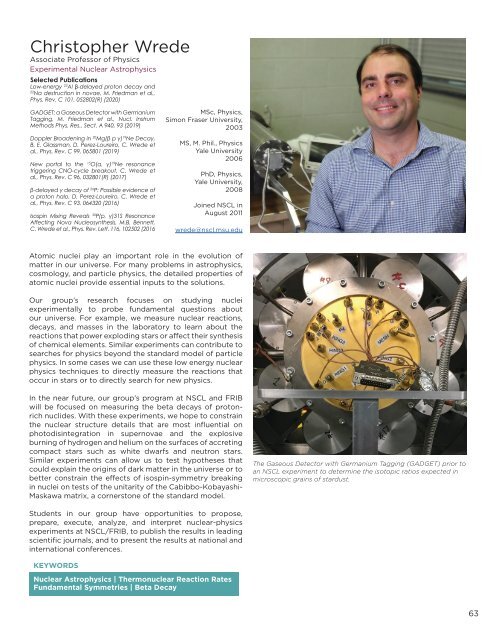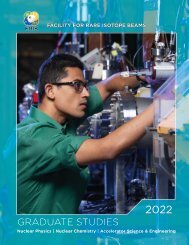2021FRIB/NSCL Graduate Brochure
You also want an ePaper? Increase the reach of your titles
YUMPU automatically turns print PDFs into web optimized ePapers that Google loves.
Christopher Wrede<br />
Associate Professor of Physics<br />
Experimental Nuclear Astrophysics<br />
Selected Publications<br />
Low-energy 23 Al β-delayed proton decay and<br />
22<br />
Na destruction in novae, M. Friedman et al.,<br />
Phys. Rev. C 101, 052802(R) (2020)<br />
GADGET: a Gaseous Detector with Germanium<br />
Tagging, M. Friedman et al., Nucl. Instrum<br />
Methods Phys. Res., Sect. A 940, 93 (2019)<br />
Doppler Broadening in 20 Mg(β p γ) 19 Ne Decay,<br />
B. E. Glassman, D. Perez-Loureiro, C. Wrede et<br />
al., Phys. Rev. C 99, 065801 (2019)<br />
New portal to the 15 O(α, γ) 19 Ne resonance<br />
triggering CNO-cycle breakout, C. Wrede et<br />
al., Phys. Rev. C 96, 032801(R) (2017)<br />
β-delayed γ decay of 26 P: Possible evidence of<br />
a proton halo, D. Perez-Loureiro, C. Wrede et<br />
al., Phys. Rev. C 93, 064320 (2016)<br />
Isospin Mixing Reveals 30 P(p, γ)31S Resonance<br />
Affecting Nova Nucleosynthesis, M.B. Bennett,<br />
C. Wrede et al., Phys. Rev. Lett. 116, 102502 (2016<br />
MSc, Physics,<br />
Simon Fraser University,<br />
2003<br />
MS, M. Phil., Physics<br />
Yale University<br />
2006<br />
PhD, Physics,<br />
Yale University,<br />
2008<br />
Joined <strong>NSCL</strong> in<br />
August 2011<br />
wrede@nscl.msu.edu<br />
Atomic nuclei play an important role in the evolution of<br />
matter in our universe. For many problems in astrophysics,<br />
cosmology, and particle physics, the detailed properties of<br />
atomic nuclei provide essential inputs to the solutions.<br />
Our group’s research focuses on studying nuclei<br />
experimentally to probe fundamental questions about<br />
our universe. For example, we measure nuclear reactions,<br />
decays, and masses in the laboratory to learn about the<br />
reactions that power exploding stars or affect their synthesis<br />
of chemical elements. Similar experiments can contribute to<br />
searches for physics beyond the standard model of particle<br />
physics. In some cases we can use these low energy nuclear<br />
physics techniques to directly measure the reactions that<br />
occur in stars or to directly search for new physics.<br />
In the near future, our group’s program at <strong>NSCL</strong> and FRIB<br />
will be focused on measuring the beta decays of protonrich<br />
nuclides. With these experiments, we hope to constrain<br />
the nuclear structure details that are most influential on<br />
photodisintegration in supernovae and the explosive<br />
burning of hydrogen and helium on the surfaces of accreting<br />
compact stars such as white dwarfs and neutron stars.<br />
Similar experiments can allow us to test hypotheses that<br />
could explain the origins of dark matter in the universe or to<br />
better constrain the effects of isospin-symmetry breaking<br />
in nuclei on tests of the unitarity of the Cabibbo-Kobayashi-<br />
Maskawa matrix, a cornerstone of the standard model.<br />
The Gaseous Detector with Germanium Tagging (GADGET) prior to<br />
an <strong>NSCL</strong> experiment to determine the isotopic ratios expected in<br />
microscopic grains of stardust.<br />
Students in our group have opportunities to propose,<br />
prepare, execute, analyze, and interpret nuclear-physics<br />
experiments at <strong>NSCL</strong>/FRIB, to publish the results in leading<br />
scientific journals, and to present the results at national and<br />
international conferences.<br />
KEYWORDS<br />
Nuclear Astrophysics | Thermonuclear Reaction Rates<br />
Fundamental Symmetries | Beta Decay<br />
63






